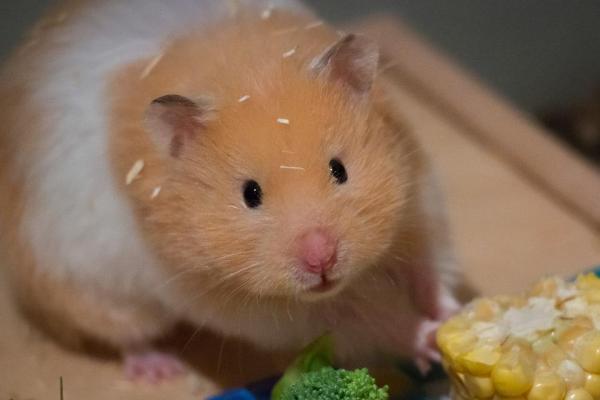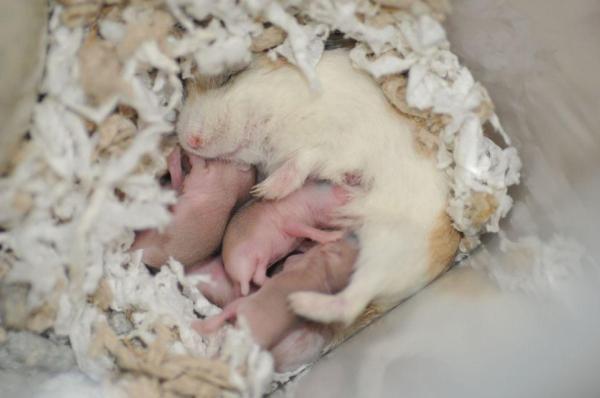
Hamsters are an all time favorite rodent to have as a pet. If you have chosen to adopt a couple of hamsters, it is possible that your female might become pregnant. In this case, it will be essential to offer her the optimal conditions she needs for the development of her pregnancy and the growth of her offspring.
In this AnimalWised article, we tell you how to care for a pregnant hamster and aim to help you maintain your animal’s health throughout her gestation and lactation period. We will also give you some tips to ensure that her offspring are born and grow up in a safe environment where they can develop strong and healthy.
Symptoms of a pregnant hamster
The gestation period of a hamster will depend fundamentally on its breed, but it can also vary according to the organism of each female. Usually, they are very short pregnancies that can last between 15 and 25 days.
This means that in order to provide adequate care for your hamster during her pregnancy, it will be necessary to recognize her pregnancy symptoms early. The number of offspring per gestation will also depend on the type of hamster you have: while a Russian hamster usually gives birth to 4 to 8 offspring, a golden hamster can give birth to 20 offspring.
Unfortunately you cannot notice abdominal dilation in a hamster until her last 5 days of gestation, this means in order to know if your hamster is pregnant, it is important to note other signs, such as;
- Increased appetite: If your hamster starts to consume a lot of water or if her appetite increases suddenly this can be a sign that she might be pregnant. In addition to a possible pregnancy symptom, alterations in appetite may indicate some common diseases in hamsters or reveal that your female feels anxious, nervous or is being exposed to high levels of stress.
- Sudden weight gain: If your female consumes more food than normal, it is logical she will get fat quickly. In addition, weight gain is also part of a pregnancy, since the young grow rapidly in the womb.
- Swollen nipples: If you observe that your hamster’s nipples are swollen, this is a symptom that your hamster’s body is preparing for lactation.
- Strange/ Different behavior: If your female is pregnant, she will begin to build a nest inside the cage and store food inside the nest for the day of delivery. During the first days of pregnancy, females tend to be more aggressive, especially towards males. But once she has given birth and time passes, her temperament will calm and your hamster might sleep and rest for long hours.

Caring for a pregnant hamster: veterinary follow-up
If you distrust that your hamster is pregnant or have observed any of the above mentioned symptoms, we recommend consulting your veterinarian. In a clinic, not only will a professional confirm the pregnancy, but they can also verify the state of health of the female and guide you to specific requirements she may need during her pregnancy and lactation period.
You can also take this opportunity to clarify your doubts about how many babies your hamster will give birth to and when next you should return to do a general examination of the baby hamsters. In addition, do not forget that periodic visits to a specialized veterinarian are part of the essential care of your hamster.
Feeding a pregnant hamster
Although hamsters must receive a balanced diet throughout their lives, pregnant females will need special attention when it comes to their feeding. During pregnancy, your hamster will require a high-energy intake diet. This diet will prepare her body for breastfeeding and allow for the proper development of her offspring.
Ideally, you should increase her daily intake of protein and good fats. Increase the presence of foods such as: boiled eggs, lean cheeses, boiled chicken or turkey, cooked ham , cereals and nuts (walnuts, almonds, hazelnuts, chestnuts and pips). You can also offer her flour worms or other small insects, which are sold in some veterinary and pet stores.
These recommended fruits and vegetables will also help strengthen the immune system of your pregnant female and provide her with a large amount of vitamins, fibers and minerals. Remember to preference foods of organic origin (grown without pesticides) and remove the seeds and outer skin of the fruits before offering them to your rodent. And logically, always avoid foods prohibited for hamsters.
During pregnancy, we recommend applying the "ad libitum" system to feed your female. That means that you should leave food and fresh water at her disposal throughout the day. The females will look for food not only because they are hungry, but also to store for when she births her babies.

Preparing your hamster’s cage and environment for her young
As we have already mentioned, pregnant hamsters tend to become more aggressive because they feel vulnerable. They will feel the need to defend their territory to ensure that their offspring are born in a safe environment. Therefore, we must separate the pregnant female from other hamsters, preparing a cage exclusively for her and her future babies.
In this cage, your hamster have fresh water and food at her disposal. She will also need materials to make her nest, such as straw, wood and twigs. During her gestation period, it will be essential to keep your hamster’s cage clean, removing food and excrement remains daily. But if the female has already started to build her nest, be careful not to interrupt this process.
Gestation is a very delicate period for a female. Your hamster will experience numerous physiological, hormonal and behavioral changes. Therefore, beyond preparing her cage, it is also essential to provide her with a calm and positive environment, where she can carry out a safe and peaceful gestation. To avoid exposing her to high stress contexts, you should not touch or approach the cage very often. Although it is important to transmit love and give affection to your pregnant hamster, you will also need to respect her territory.
Caring for her young
Once your hamster has given birth you should give her privacy during breastfeeding and respect her time of adaptation. You should only approach the cage to replace her water and food, temporarily suspending sanitization. You must not, under any circumstance, touch the mother or her newborn offspring . This can be interpreted as a sign of weakness and the mother hamster will then eat her young because they will be considered fragile, threatened and unable to survive.
In addition, to prevent your hamster from eating her young, you can follow some preventive measures, such as providing a balanced diet of optimal quality, ensuring she is in a calm and confident environment, and keep her separate from other hamsters during her pregnancy and breastfeeding period.
After 20 days of delivery, you will be able to return to her cage and resume your daily cleaning. Both the mother and her children will be ready to play with you and receive your affection. It will also be time to "introduce" the new members of the family to the other hamsters. This will be an excellent opportunity to take the young to the vet and begin to manage their growth.
From their third week, baby hamsters are ready to be weaned, so you should be attentive to feed and care for the young. In addition, from their fifth week, small rodents start to mature sexually. Therefore, you should seriously consider separating the males and the females in order to avoid fights and new unplanned litters.
Imagen: ultimatepethub.com

The reproductive system of your hamsters
When you unite your hamsters again, you must bear in mind that these rodents reach their sexual maturity very quickly. Your new companions will be able to mate and generate new litters from their first or second month of life (depending on the hamster's breed). In addition, females are be able to fall pregnant again about 24 hours after giving birth to their offspring.
Therefore, you should always be aware of the reproductive system of your hamsters and think very carefully before putting males and females together in the same cage. Since these rodents usually give birth to large litter, you can also consider finding responsible and caring people who want to adopt a pet hamster.
If you want to read similar articles to How To Care For A Pregnant Hamster, we recommend you visit our Gestation category.